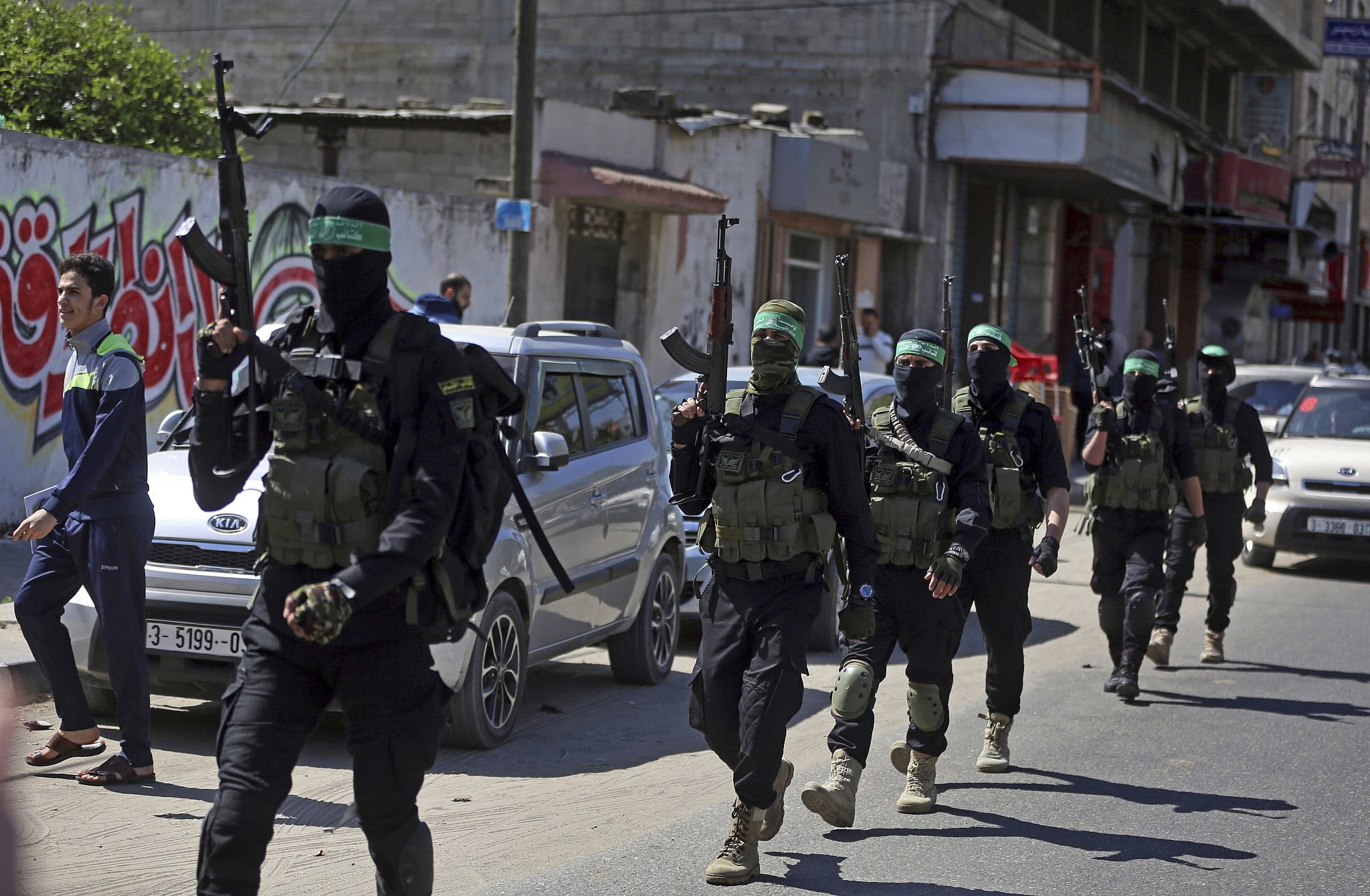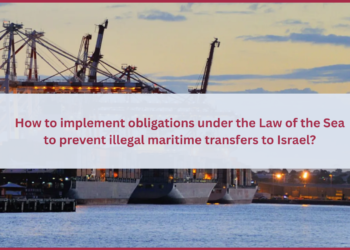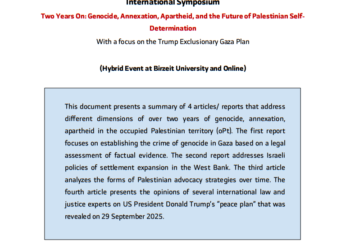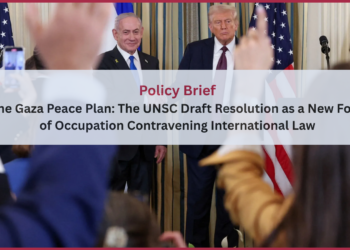Under Scrutiny: Allegations of Use of Human Shields by Palestinian Armed Groups and the International Criminal Court Investigation
Prepared by: Nida’a Yousef *
Edited by: Hiba Birat
Reviewed by: Abd al-Ghani Sayed, Ihsan Adel
* This article was translated from Arabic to English by Mariam Hussam Alqam, and edited by Ahmed Almassri
* To download the paper in pdf format, click here (12 pages)
*This article is part of a series of articles on the responsibility of Palestinian Armed Groups (PAGs) before the International Criminal Court (ICC), as part of Law for Palestine’s call for submissions in this area.[1]
Introduction
On 5 February 2021, the Pre-Trial Chamber I of the ICC decided that the Court’s territorial jurisdiction extends to the territories occupied by Israel since 1967, namely Gaza and the West Bank, including East Jerusalem.
Even though the court resolution has gained currency on a Palestinian national level, as to hold Israel accountable for its crimes against the Palestinian people — especially those committed in the 2014 Gaza war —, legal experts still question what the resolution means with regard to allegations of war crimes committed by the PAGs in Gaza, including the alleged use of human shields during the war with Israel.
This paper will address the issue of the use of human shields in accordance with the laws of war and the other relevant laws on Palestine before the ICC. The paper also seeks to highlight the legal characterization of this crime under both International Humanitarian Law (IHL) and International Criminal Law (ICL). Moreover, it addresses the alleged use of human shields by the PAGs, analyzes their legal responsibility, and examines the impact of this characterization on Israel’s attempt to evade responsibility for carrying out indiscriminate attacks.
Conceptual Background
Legal Definitions on the Use of Human Shields
Considering the legal texts addressing the concept of human shields in each of the four Geneva Conventions of 1949, the Additional Protocol I of 1977, and the founding Charter of the International Criminal Court (Rome Statute), the International Committee of the Red Cross (ICRC) defines the term as “utilizing the presence of a civilian or other protected person to render certain points, areas or military forces immune from military operation.”
The use of human shields is usually addressed either in the military manuals of countries, such as Britain and New Zealand, or through reciprocal international condemnations of certain incidents in which human shields have been used.
The examples mentioned in some of these manuals can be used to show what is meant by the use of human shields. These include, but are not limited to: placing civilians at a military objective with the aim of protecting and shielding that objective, using prisoners of war to shield military objectives, moving civilians in places where weapons and ammunition are located, or placing civilians on the front lines during confrontation to shield military units.
It can be concluded that for a state to be accused of the use of human shields, their military sites need to be mixed up or built adjacent, near or within civilian sites and/or persons unable to fight, with the intention of preventing the targeting of such points or military objectives.
Effective Laws on the Use of Human Shields
Article 21 of the 1998 Rome Statute, which governs the work of the ICC, includes a list of applicable laws that the Court shall apply, including the Rome Statute itself. The Court shall make use of the official records of the Assembly of States Parties to the Rome Statute, with regard to the Elements of Crime and its Rules of Procedure and evidence. In a second place, the Court shall apply applicable treaties and the principles and rules of international law, including the established principles of the international law of armed conflict. Failing to do so means that the general principles of law derived by the Court from national laws of legal systems of the world shall be applied.
Generally, the effective laws regarding the issue of the use of human shields during war derive from IHL, which represents the most comprehensive framework for the laws followed and applied in war situations, in both customary and contractual aspects. Provisions relating to the use of civilians as human shields are contained in the Hague Conventions of 1907, namely the Fourth Convention on the Respecting the Laws and Customs of War on Land and its annex, the Third Geneva Convention Relative to the Treatment of Prisoners of War, the Fourth Geneva Convention Relative to the Protection of Civilian Persons, and in the Additional Protocol I to Geneva Conventions. At the ICC level, this issue was addressed in the Rome Statute.
The International Legal Framework on the Use of Human Shields
– Customary International Humanitarian Law (IHL)
Attempts have recently been made to codify Customary rules in IHL by the ICRC, which has produced a database containing all the rules. With regard to the use of human shields, Rule 97 of Customary IHL prohibits the use of human shields in armed conflicts.
In many cases, the use of human shields has been treated as tantamount to the taking of hostages, which is prohibited by Article 4(2)(c) of Additional Protocol II and Rule 96 of Customary IHL. Deliberately using civilians to shield military operations is contrary to the principle of distinction and violates the obligation to take feasible precautions to separate civilians and military objective
– The Hague Convention
The Hague Convention on respecting the Laws and Customs of War on Land and its annex prohibits the targeting of civilians. In Article (27), the responsibility of the parties to the conflict to take precautions and measures to immunize civilian areas and centres from military attacks is addressed. The said article states that, “In sieges and bombardments all necessary steps must be taken to spare, as far as possible, buildings dedicated to religion, art, science, or charitable purposes, historic monuments, hospitals, and places where the sick and wounded are collected, provided they are not being used at the time for military purposes. It is the duty of the besieged to indicate the presence of such buildings or places by distinctive and visible signs, which shall be notified to the enemy beforehand.”
– The Geneva Conventions and Additional Protocol I
The Geneva Conventions provide guarantees to protect civilians from military attacks, by emphasizing that parties to the conflict should take the necessary precautions to remove civilian posts from military objectives, to avoid casualties. This was stipulated in Articles 19(2) and 32(1) of the First Geneva Convention of 1949, Article 23 of the Third Geneva Convention, and Article 28 of the Fourth Geneva Convention: that the presence of a civilian or other protected person, shall not be exploited to render certain points, areas or military forces immune from military operation.
Additionally, Articles 12(4) and 51(7) of the 1977 Additional Protocol I prohibit the exploitation of the presence or movements of civilians to shield military objectives, “in particular in attempts to shield military objectives from attacks or to shield, favour or impede military operations. The Parties to the conflict shall not direct the movement of the civilian population or individual civilians in order to attempt to shield military objectives from attacks or to shield military operations.”
In the context of determining the duty and responsibilities of the Parties to the conflict to take the necessary precautions, Article 58 of Additional Protocol I stipulates that “the Parties to the conflict shall, to the maximum extent feasible”:
- endeavour “to remove the civilian population, individual civilians and civilian objects under their control from the vicinity of military objectives,” without prejudice to Article 49 of the Fourth Convention;
- “avoid locating military objectives within or near densely populated areas”;
- “take other necessary precautions to protect civilians and civilian objects” under their control against “the dangers resulting from military operations.”
– The Rome Statute, Elements of Crime – Official Records of the Assembly of States Parties to the Rome Statute:
Article 8 (2)(b)(xxiii) of the Statute of the ICC provides that “utilizing the presence of a civilian or other protected person to render certain points, areas, or military forces immune from military operation” constitutes a war crime. Beside that, we have to look at the Elements of Crime, which was published with the aim of assisting the Court in the interpretation and application of the articles of the Rome Statute, and are essentially derived from the Official Records of the Assembly of States Parties to the Rome Statute. As for the Elements of Crime of using human shields, stipulated in Article 8(2)(b)(xxiii) previously mentioned, they are as follows:
- The perpetrator moved or otherwise took advantage of the location of one or more civilians or other persons protected under the international law of armed conflict;
- The perpetrator intended to shield a military objective from attack or shield, favour or impede military operations;
- The conduct took place in the context of and was associated with an international armed conflict;
- The perpetrator was aware of factual circumstances that established the existence of an armed conflict.
– Legal Precedents on the Use of Human Shields
The International Criminal Tribunals have already heard cases of using civilians as human shields. Some of the cases brought before these courts, include the case of Radocan Karadzic and Ratko Mladic who were brought before the International Criminal Tribunal for the former Yugoslavia (ICTY) and charged for several war crimes committed against Muslim Serbs and Bosnians, including for the use of human shields. Their indictment stated that they individually, and in concert with others, planned, instigated, or otherwise aided and abetted in the planning of the taking of civilians, that is UN peacekeepers, as hostages and using them as human shields. They knew or had reason to know that subordinates were about to take and hold UN peacekeepers as hostages and about to use them as human shields, and failed to take necessary and reasonable measures to prevent them from doing so or to punish the perpetrators thereof. Subsequently, they were convicted of inhuman treatment under Articles 2(b), 7(1), and 7(3) of the ICC Statute, and of violating the laws and customs of war (brutal treatment) under Articles 3, 7(1), and 7(3) of the ICC Statute.
The Court’s ruling was based on the intent of crime, the awareness of the officials, in addition to their failure to take the necessary and relevant measures.
The Alleged Use of Human Shields by Palestinian Armed Groups
– Criminal Intent
Attempting to refute Israel’s violation of the principles of distinction and proportionality by harming civilians and their property, Israeli reports claim that Israel is engaged in a war on terror. That is, Hamas’s method of warfare, inspired by Hezbollah’s method in Lebanon, was based on the alleged use of civilians as human shields by forcing residents to stay at home, assimilating into civilian neighborhoods disguised in civilian attires, surrounding combatants with children to facilitate their escapes, making military use of civilian houses during operations and firing rockets and mortar shells from there, and summoning civilians to serve as human shields to protect combatants.
In order to examine the extent to which the Elements of Crime apply to the actions of the PAGs, we consult Article 8(2)(b)(xxiii) of the official records of the Rome Statute, which mentions the elements of the crime of using human shields. Our conclusion is that three of the four elements do in fact apply to the case of the PAGs; namely, the first element (taking advantage of the location of civilians), the third element (being a party to an international armed conflict). and the fourth element (being aware of factual circumstances that established the conflict). The second element, which in our opinion is the most important, is related to the element of intent on the part of the PAGs.
The analysis is based on Customary IHL and the aforementioned articles. In particular, Rule 22 of Customary IHL expressly states that: “Parties to the conflict must take all feasible precautions to protect the civilian population and civilian objects under their control against the effects of attacks.” Rule 23 of customary IHL also states that, “Each party to the conflict must, to the extent feasible, avoid locating military objectives within or near densely populated areas.” Additional Protocol I, Article 57(2) and Article 28 of the Fourth Geneva Convention clarify the precautions to be followed by the Parties for the purpose of not causing harm to the lives of the civilian population. Attacks on Gaza have taken place in areas of high population density. Thus, military operations may be carried out in close proximity to civilians, not with that same intent, but because of the nature of the place and the density of the population. However, does this exempt the Palestinian armed groups from responsibility?
As can be seen from the second element to the crime of using human shields, the PAGs must have the intention to use the protected civilians in these densely populated areas to protect or render military objectives immune from attack. Thus, if the Commission of Inquiry does not have sufficient evidence to establish the particular intent of the PAGs to use civilians for protection, counter military attacks, or achieve military ends, then the PAGs cannot be accused of the crime of using human shields.
Perhaps it is important to refer here as well to the report of the UN Commission of Inquiry into the 2014 war in Gaza. The report condemned in para. 483 calls by Hamas for Gazans to shield their homes from Israeli attack by going up on their roofs. These calls, as stated in the report, can be understood as an encouragement for the PAGs to use human shields. In our view, the Committee’s position here is determined by examining the element of intent, as previously stated.
Article 58 of Additional Protocol I determines the duty of the parties to a conflict to take the necessary precautions to spare civilians under their control. The language of the article also places emphasis on the idea of capability and the link of responsibility to ability (maximum extent feasible, endeavour, avoid, take other necessary precautions). This is an important issue in terms of the spatial specificity of Gaza. It is a small and densely populated geographical area which has been under Israeli siege since 2007 and extends over an area of 360 km2 with a population of up to two million people. This creates a problem of overcrowdedness and limits the possibility of sparing civilians the attacks. Here, the balance of power cannot be overlooked when addressing the asymmetric capabilities possessed by the parties to the conflict, particularly the limited capacity of armed groups in Gaza, which should be taken into account in the Court’s assessment of the extent of liability and aspects of negligence.
It is true that this does not negate the responsibility of these groups to protect civilians, but what matters here is to prove or deny the limits of the extent practicable, depending on the spatial and temporal specificity and balance of power that determines each party‘s ability to take the necessary measures to protect civilians and spare them the dangers of war.
That is exactly what the Goldeston Report by the UN Fact-Finding Mission into the Gaza conflict of the war of 2008-2009 referred to. The Mission had received numerous reports accusing the PAGs of not taking adequate measures to distinguish themselves from civilians. They were further accused of blending in with civilians and wearing civilian clothing while fighting. The Mission’s response was that the PAG’s “failure to distinguish themselves from the civilian population by distinctive signs is not a violation of international law in itself, but would have denied them some of the legal privileges afforded to combatants.” The mission also found no evidence that members of the PAGs had in fact engaged in fighting in civilian dress, and the Goldstone report (paragraphs 450, 451, 452) stated that it did not encounter any evidence of the required criminal intent of the PAGs to protect their fighters from attacks by the IDF.
Voluntary human shields protection under IHL
The aforementioned laws mention the use of civilians as human shields, but how does IHL define civilians, and can this definition be different if a civilian volunteers as a human shield?
Civilians who use weapons or other means to directly participate in hostilities subject themselves to enemy attacks, on the grounds that the enemy, too, is exercising its right to self-defense.
IHL defines civilians as persons who are not members of the armed forces. Unlike combatants, civilians are not forced to carry any identification documents or wear distinctive clothing and symbols to confirm their civilian status during conflicts. In a situation of doubt as to whether a person is a civilian, the general rule is that the person shall be considered civilian, unless proven otherwise. Accordingly, such persons in question shall enjoy the necessary protection for civilians in accordance with the law, including protection from all forms of violence and, degrading treatment, including murder and torture. They are also entitled, if tried, to a fair trial that provides them with all the basic judicial guarantees, as affirmed in Rule 6 of Customary IHL.
The international laws of war make it clear that civilians shall enjoy protection against the dangers arising from military operations unless and for such time as they take a direct part in hostilities. Civilians who use weapons or other means to directly participate in hostilities subject themselves to enemy attacks, on the grounds that the enemy, too, is exercising its right to self-defense.
However, what about civilians who volunteer to serve as human shields? Does this mean they are directly involved in hostilities? In other words, does that turn them into combatants? What is the impact of this on determining the responsibility of armed groups?
In principle, there is a difference in legal opinions about whether civilians involved in conflict are considered civilians. Some argue that they turn from being civilians to being combatants. For example, Canada‘s LAOC Manual (2001) states in its chapter entitled “Combatant Status” that civilians who take a direct role in hostilities (other than a levée en masse) are unlawful combatants. They lose their protection as civilians and become legitimate targets for such time as they take a direct part in hostilities. As for the other opinion, the practice of civilians in hostilities does not result in them becoming combatants, but when they stop fighting or become unable to fight, they retain their civilian status. In cases of falling into enemy hands, they will be entitled to their civilian status and do not acquire the status of prisoners of war.
In the debate on what constitutes direct participation in hostilities and whether their status as civilians turns into one of combatants, Michael Schmidt argued that voluntary human shields in conflict which make military objectives immune from attack (or contribute to the enemy’s reluctance to attack) contribute to the survival of the objective; hence, by definition, contribute to military action. Thus, they contribute to this work in a very direct way.
Indeed, by immunizing the military objective against attack as a matter of law, shields are in many cases more effective than conventional defenses such as anti-aircraft artillery or surface-to-air missiles. This is what prompted many to support Schmidt’s opinion, and thus support the de-civilianizing of human shield volunteers.
On the other hand, direct participation has been interpreted to include “carrying out hostile act against the adversary; killing or taking prisoners; destroying military equipment, gathering information in the area of operations; supervise such operation; service such equipment; transmitting information concerning targets and taking part of the logistics activities of military operations,” which is more consistent with what is stated in IHL.
Shannon Bosch concludes that voluntary human shields in civilian settings retain their civilian status, and cannot be said as directly involved in hostilities. While it can be argued that voluntary human shields presented in individual (or exclusive) military positions are directly involved in hostilities, such as workers in ammunition factories, they are not legitimate military targets. However, their presence in a legitimate military objective leaves them vulnerable to attack with less regard for collateral damage than if they were unsuspected civilians. In the event that they are proven to be located in a place with a dual civilian and military character, the dual-use protection sites must be granted civilian status until such time as they can be verified by a court of military status.
Adil Haque argues in his article that civilians who are voluntarily used as human shields continue to retain their basic rights, but what they do may put them at risk for these rights, and that some of them may therefore be considered collateral damage of war, but they generally remain civilians. As for those who are forcibly used as human shields, they retain their basic rights. The principle of proportionality in the event that they are considered collateral damage is not invalidated, but rather remains in place and is not affected.
We conclude from the foregoing that the character of volunteering as human shields in principle does not remove the civilian status and legal protections accorded to it under international law. Volunteers shall retain their civilian status unless proven otherwise. The only case where IHL permits a civilian to take part in war; and for the laws of war to recognize them as combatants is in the case of a levée en masse.
On the one hand, it is dangerous to provide that voluntary human shields as inevitable collateral damage of war that could not have been avoided, i.e. dropping charges of breaching the principle of proportionality, principle of distinction, and principle of humanity from the attacking party in some cases. On the other hand, according to Schmidt and other jurists, if civilian volunteers are treated as combatants and de-civilianized, they may drop charges against the PAGs for their use of human shields.
In any case, the question of having a specific intent is important here, and so is examining whether the intention was to protect the military objective and fortify it from counterattack. This point seems important not only to examine the responsibility of the civilians involved and of the PAGs, but also to examine the extent to which Israel is responsible for attacking these targets and the wide margin of collateral civilian casualties.
In any case, Adil Haque argues, in the context of practice and contemporary armed conflict, that the military command of the attacking adversary is not in a state that allows for distinguishing between voluntary and involuntary human shields. The military context makes this almost impossible during the time of attack, and therefore the question of an attacker knowing that there are human shields, regardless of whether they are voluntary or not, is an issue that should warrant the criminalizing of the attacking party in both cases.
As for the PAGs, we should ask the most prominent question in this regard: Does proving the de-civilianization of volunteers concurrently maintain the responsibility of the PAGs towards using civilians as human shields? Would the Palestinian side compromise on its right to hold Israel accountable for its crimes against some civilians who have been proven to be voluntary human shields? There does not seem to be a specific answer in particular, as the Palestinian situation in the Gaza Strip has a specificity on which the Court will say its word, and new facts may emerge during the Court’s investigations that would prevail.
Lastly, the report of the UN Commission of Inquiry into the 2014 war in Gaza (para. 483) stated that, in one case, following a specific warning by the Israeli army that a residential building was being targeted, several people went to the roof of the house in order to “protect” it. The report concluded that should these civilians have been directed to do so by members of the Palestinian armed groups, this would amount to the use of the presence of civilians in an attempt to shield a military objective from attack. Thus, if civilians were doing this on their own, then no responsibility could be envisaged.
Recommendations and Conclusion – Human Shields and Palestinian Groups
Israel will try to defend itself – whether through the Court or through its political discourse – regarding the commission of war crimes by claiming that the PAGs are terrorist groups and that the war on Gaza was a war on terror where terrorists do not shy away from using civilians as human shields. However, it will face obstacles relating to the characteristics of the Palestinian situation in the Gaza strip and the possibilities of taking “all the possible limits of necessary measures and precautions” to protect civilians and spare them from military attacks. The same applies to proving that the PAGs have in fact used civilians as human shields. Israel may not always be exempt from violating the principles and rules of IHL in its actions towards Palestinians, particularly the principle of distinction, principle of proportionality, and the principle of humanity, which obligate its forces to distinguish between civilians and combatants and direct attacks at military objectives only. It remains unclear how the so-called “direct military objective” will be assessed, especially in regards to collateral damage inflicted on civilians, and the same goes for assessing the means and methods of warfare used to cause unnecessary suffering.
With regard to the responsibility of the PAGs for the use of human shields, we do not have a completely specific answer about the Court’s approach in this regard. However, we believe that the Elements of Crime may not be fully met in light of the lack of evidence. This has been stated in previous UN reports, particularly the Goldstone report and the 2014 report of the UN Commission of Inquiry. What is certain, so far, is that the allegation that the armed groups are using human shields is unsubstantiated, and even the Prosecutor’s Office does not seem to have evidence on this regard, because the evidence at our disposal is the same as that which was available to the Prosecutor’s Office at this stage of the investigation. A quick skim through the sources of information in the annual preliminary investigation reports over the past decade indicates that, during that initial investigation period, the sources of information were essentially “open source” and publicly available, which includes reports published by governmental and non-governmental entities. Relaying on confidential sources or information that is not publicly available at this stage of the investigation could be shaky.
Therefore, based on the allegations, video clips and images surfaced by Israel on the Internet, the same ones available to the Public Prosecution Office of the Court, in our opinion are inadequate to find all elements of crime present.
The Court may, of course, take a different approach. New facts may emerge during the investigation that indicate the involvement of the PAGs. The Court may say its word on the question of the voluntary participation of Gaza residents in protecting the actions of the armed groups in terms of whether or not they have the specific intent, the applicability of the elements of the crime, or the preservation of the status of civilians. This does not mean, in any case, that the PAGs are exempt from other legal obligations. Only time and the start of the actual investigation can reveal this.
_____________________
[1] Law for Palestine bears no responsibility for the content of the articles published on its website. The views and opinions expressed in these articles are those of the authors and do not necessarily reflect the official policy or position of the Organisation. All writers are encouraged to freely and openly exchange their views and enrich existing debates based on mutual respect.
—-

* Nida’a Yousef: Legal researcher at Law for Palestine. She holds a bachelor’s degree in law with a minor in English translation, and a master’s diploma in democracy and human Rights. Yousef worked as a research assistant at Muwatin Institute for Democracy and Human Rights at Birzeit University, and participated in different research projects funded by the Global Campus of Human Rights.
Tags: Human Shields Palestinian Groups





